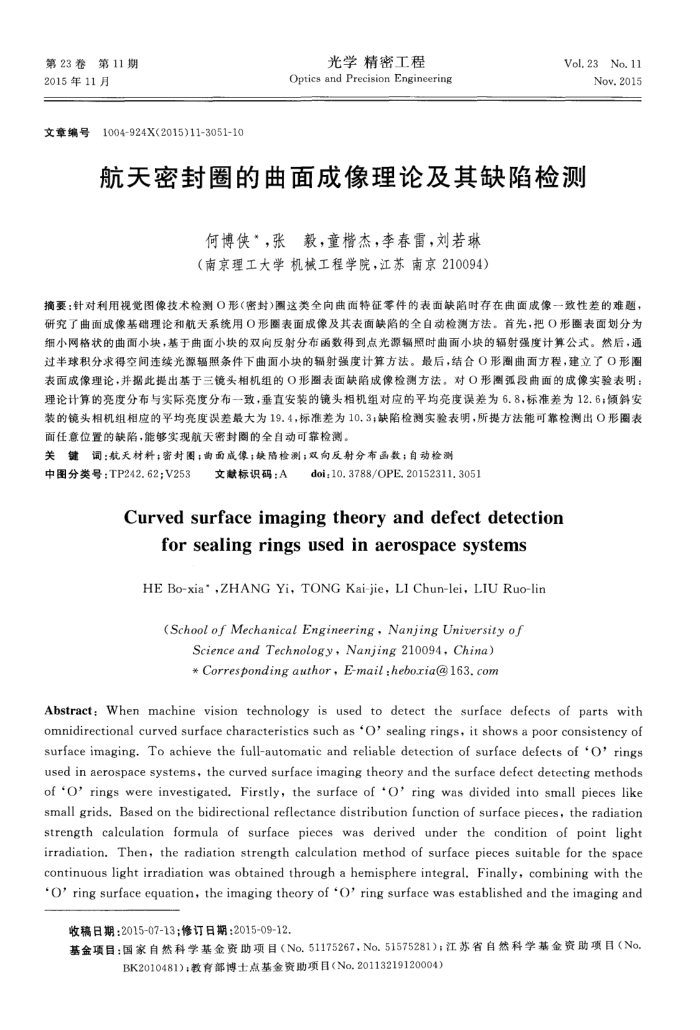您当前的位置:首页>论文资料>航天密封圈的曲面成像理论及其缺陷检测
内容简介
 第23卷第11期 2015年11月
第23卷第11期 2015年11月文章编号
1004-924X(2015)11-3051-10
光学精密工程
Optics and Precision Engineering
Vol. 23No.11
Nov.2015
航天密封圈的曲面成像理论及其缺陷检测
何博侠*,张毅,童楷杰,李春雷,刘若琳(南京理工大学机械工程学院,江苏南京210094)
摘要:针对利用视觉图像技术检测O形(密封)圈这类全向曲面特征零件的表面缺陷时存在曲面成像一致性差的难题,研究了曲面成像基础理论和航天系统用O形圈表面成像及其表面缺陷的全自动检测方法。首先,把O形圈表面划分为细小网格状的曲面小块,基于曲面小块的双向反射分布函数得到点光源辐照时曲面小块的辐射强度计算公式。然后,通过半球积分求得空间连续光源辐照条件下曲面小块的辐射强度计算方法。最后,结合O形圈曲面方程,建立了O形圈表面成像理论,并据此提出基于三镜头相机组的O形圈表面缺陷成像检测方法。对O形圈弧段曲面的成像实验表明:理论计算的亮度分布与实际亮度分布一致,垂直安装的镜头相机组对应的平均亮度误差为6.8,标准差为12.6;倾斜安装的镜头相机组相应的平均亮度误差最大为19.4,标准差为10.3;缺陷检测实验表明,所提方法能可靠检测出O形圈表面任意位置的缺陷,能够实现航天密封圈的全自动可靠检测。
关键词:航天材料;密封图;曲面成像;缺陷检测;双向反射分布函数;自动检测
中图分类号:TP242.62;V253
文献标识码:A
doi,10.3788/OPE. 20152311.3051
Curved surface imaging theory and defect detection
forsealingringsusedinaerospacesystems
HE Bo-xia',ZHANG Yi, TONG Kai-jie, LI Chun-lei, LIU Ruo-lin(Schoolof MechanicalEngineering,NanjingUniversityof
Scienceand Technology,Nanjing 210094,China) +Corresponding author,E-mail:hebozia@163.com
Abstract: When machine vision technology is used to detect the surface defects of parts with omnidirectional curved surface characteristics such as *O' sealing rings, it shows a poor consistency of surface imaging. To achieve the full-automatic and reliable detection of surface defects of O' rings used in aerospace systems, the curved surface imaging theory and the surface defect detecting methods of "O' rings were investigated. Firstly, the surface of 'O' ring was divided into small pieces like small grids. Based on the bidirectional reflectance distribution function of surface pieces, the radiation strength calculation formula of surface pieces was derived under the condition of point light irradiation. Then, the radiation strength calculation method of surface pieces suitable for the space continuous light irradiation was obtained through a hemisphere integral. Finally, combining with the"O' ring surface equation, the imaging theory of ‘O' ring surface was established and the imaging and
收稿日期:2015-07-13;修订日期:2015-09-12,
基金项目:国家自然科学基金资助项目(No.51175267,No.51575281);江苏省自然科学基金资助项目(No
BK2010481);教育部博士点基金资助项目(No.20113219120004)
上一章:基于大气实时修正的飞机辐射特性测量
下一章:仿昆扑翼微飞行器电磁驱动电路设计与制造